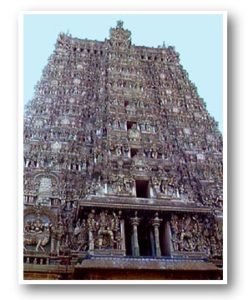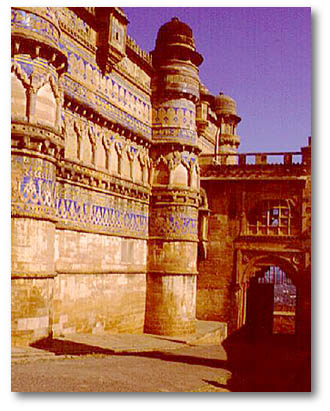One of the most enduring achievements of Indian civilization is undoubtedly its architecture, which extends to a great deal more than the Taj Mahal or the temple complexes of Khajuraho and Vijayanagara. Though the Indus Valley sites of Harappa, Mohenjo-daro, and Lothal provide substantial evidence of extensive town planning, the beginnings of Indian architecture are more properly to be dated to the advent of Buddhism in India, in the reign of Ashoka (c. 270-232), and the construction of Buddhist monasteries and stupas. Buddhist architecture was predominant for several centuries, and there are few remains of Hindu temples from even late antiquity. Among the many highlights of Buddhist art and architecture are the Great Stupa at Sanchi and the rock-cut caves at Ajanta.
By the eighth century, with the consolidation of Hindu kingdoms, the southern Hindu school of architecture was beginning to flourish. The most notable achievements of the Pallavas were the rock-cut temples of Mahabalipuram and the temples of Kanchipuram. The subsequent history of South Indian temple architecture takes us, over the next eight centuries, to Thanjavur (Tanjore), to the brilliant achievements of the Hoysalas (as seen in the temples at Belur and Halebid), and the temple complexes, which represent the flowering of the Vijayanagara empire, of Kanchipuram, Thiruvannamalai, and Vellore. The most stellar achievement of the later Vijayanagara period may well be the Meenakshi temple in Madurai. In Kerala, however, a distinct style of architecture took shape. In Ellora in western India, Hindus added a new series of temples and carvings at what had once been Buddhist caves, culminating in the majestic Kailasa temple, constructed in the reign of the Rashtrakuta monarch Krishna I (757-73), while the rock-cut caves in Elephanta and Jogeshvari, in the proximity of Bombay, were most likely executed in the sixth century.
In north India, meanwhile, architecture was to be a more contentious matter. The fabled temple at Somnath, renowned for its purported riches, is said to have been destroyed by the Muslim invader Mahmud of Ghazni, and after the attainment of Indian independence, the restoration of this temple became a matter of national pride for more ardent defenders of the faith. The story of Somnath points to the manner in which histories, whether political, cultural, or architectural, have become communalized. But the period from 1000-1300 was, in any case, a time when Hindu architecture flourished throughout India. In central India, the Chandellas built a magnificent complex of temples at their capital, Khajuraho, between 950-1030 A.D. These temples, which show Vaishnavite, Shaivite, and Tantric influence, have acquired a renewed reputation today as indices of India’s libertine past, allegedly indicative of India’s relaxed sexual mores before puritanical Muslims made India a sexually repressed society. The sexual postures depicted in many of the sculptures that adorn some of the temples appear equally on the posters of the Government of India’s Tourist Office and the pages of gay and lesbian magazines. The cultural politics of Khajuraho, as indeed of Indian architecture, still remains to be written. In the north-west, the Solanki kings spent lavishly on buildings, and the Surya or Sun temple in Modhera, some 3 hours from Ahmedabad, stills provides striking testimony to their achievements. More stupendous still is the Surya temple at Konarak, built by Narasimha-deva Ganga (c. 1238-64), though masterpieces of Orissan architecture from the reign of the Gangas are to be found in Bhubaneshwar and Puri as well. The weakness of Muslim dynasties in the north enabled Rajput kings to assert their independence; the results of this Hindu revival are to be seen in Chittor, and elsewhere in Rajasthan where massive forts dot the landscape.
The Mughal emperors of India, most particularly Humayun, Akbar, Jahangir, and Shah Jahan, were heavily invested in monumental architecture and spent lavishly on the construction of mosques, mausoleums, forts, palaces, and other buildings. The principal sites of Mughal architecture are Lahore, Delhi, Agra, and Fatehpur Sikri, though dazzling specimens of Mughal architecture are to be found elsewhere. Shah Jahan constructed a new capital, then to be known as Shahjahanabad, and now a part of Old Delhi. Its most famous buildings include the Jama Masjid, one of the largest mosques in the world, and the Red Fort (Lal Qila), which over the last four hundred years has become uniquely emblematic of state power. Akbar likewise built a new capital at Fatehpur Sikri, a few miles outside Agra, but it was abandoned on account of insuperable difficulties in obtaining a water supply. Some have described the complex of buildings at Fatehpur Sikri, which include the majestic Buland Darwaza and Salim Chisti’s tomb, as the most splendrous accomplishment of Mughal architecture. Among the most exquisite of the Mughal works of architecture are various mausoleums, including Humayun’s Tomb in Delhi, Akbar’s Tomb in Sikander on the outskirts of Agra, and the Taj Mahal, an edifice of such ravishing beauty that it has now become iconic of India itself. Mughal emperors also laid down elaborate gardens, the finest of which are to be found in Srinagar, and built elaborate forts, principally at Agra (1564-), Ajmer (1570-), Lahore (1580), and Allahabad.
Unlike the Mughals, the British contributed little to India’s architectural history. Their rule is associated mainly with monumental civic buildings, such as the Victoria Terminus in Bombay, or commemorative exercises typified by the Victoria Memorial in Calcutta. There are some notable specimens of church architecture, such as St. James’s Church in Delhi, but the principal regal contribution of the British appears to be the construction of a new capital in Delhi. Meanwhile, indigenous styles of architecture did not entirely suffer a demise, and step-wells continued to be built in Gujarat throughout the nineteenth century. In Rajasthan rich merchants constructed large havelis or residences in which the window work defies description. The most striking of these havelis are to be found in Jaisalmer, also notable for Rajasthan’s finest, certainly most romantic, fort. (See also fort architecture.) Though few people associate India with modern architecture, the work of many Indian architects, such as Charles Correa and Balkrishna Doshi, is renowned internationally. Other prominent architects include Satish Gujral, also known as a painter, and Laurie Baker, an Englishman settled in India who first became known for designing low-cost housing and using only local materials. It is also noteworthy that the city of Chandigarh was designed by Le Corbusier.




